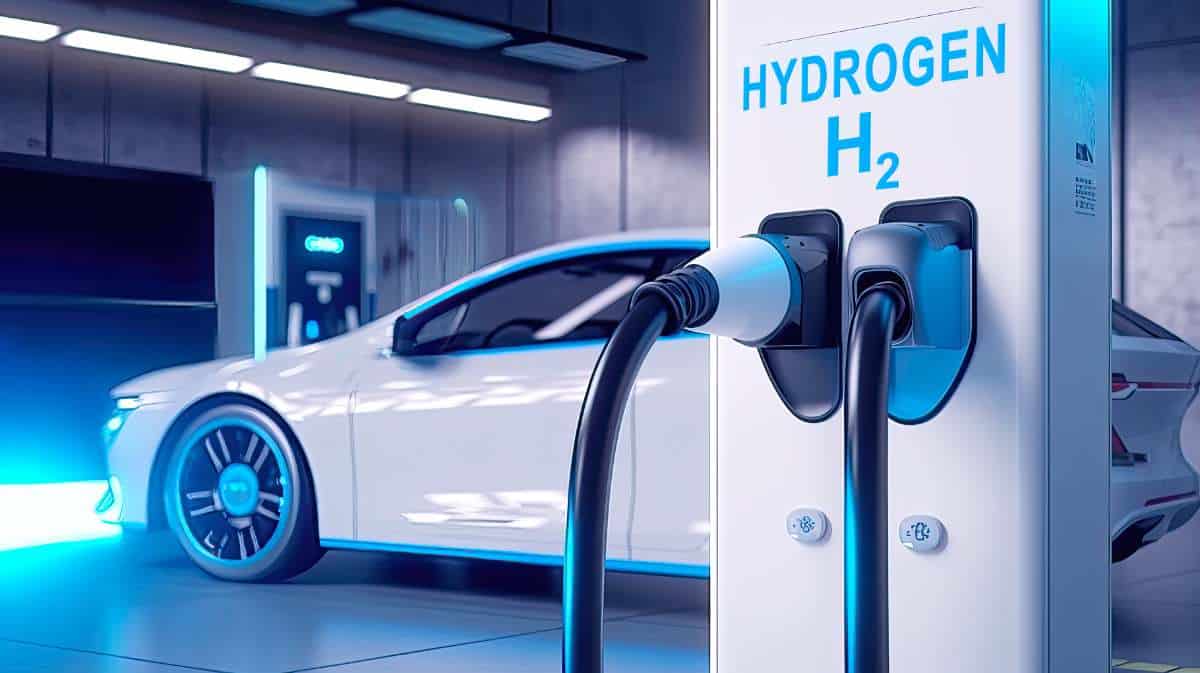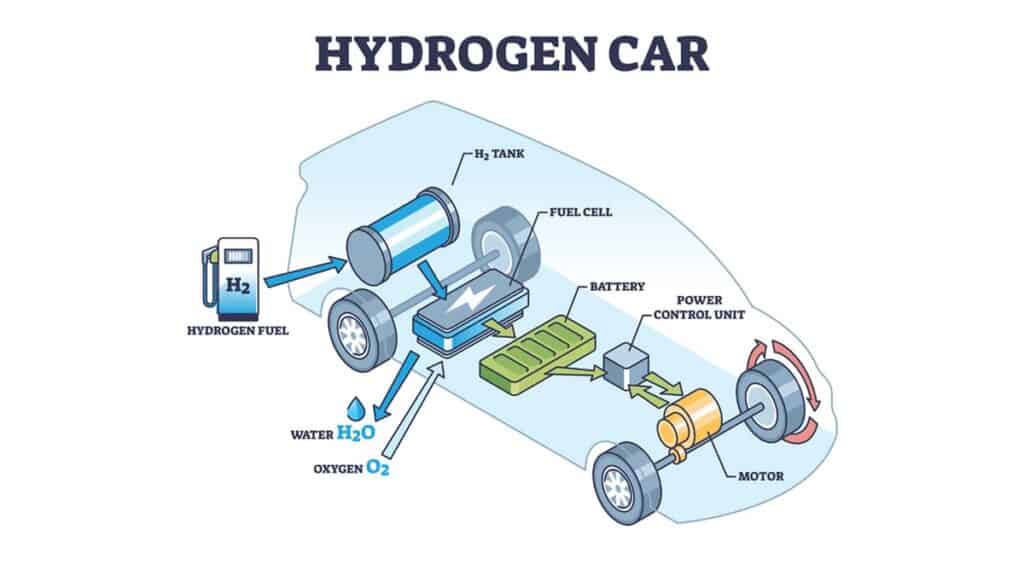Conventional cars are gradually taking a back seat, while more environmental-friendly options are cruising into the spotlight. One such innovation that’s steering us towards a cleaner future is Fuel Cell Vehicles (FCVs).
An intriguing blend of green technology and advanced engineering, FCVs are harnessing the power of alternative energy, specifically hydrogen. Imagine driving without contributing to pollution – that’s what these vehicles promise!
By transforming hydrogen into electricity within their unique fuel cells, FCVs offer a driving experience with zero emissions. It may sound like sci-fi, but it’s not, it’s very real and happening now!
In this article, I’ll guide you through how these cutting-edge vehicles function, highlight their differences from all-electric cars, and look at why the future of zero-emission vehicles may yet be dominated by the humble fuel-cell.

Key Takeaways
| 1. | A fuel cell vehicle (FCV) or fuel cell electric vehicle (FCEV) is an electric car powered by hydrogen. It uses a fuel cell and sometimes a small battery to generate electricity. |
| 2. | FCVs operate on pure hydrogen gas, stored in a tank on the vehicle, and produce instant torque and smooth power, making them fun to drive. They can refuel in about five minutes. |
| 3. | Hydrogen fuel cells generate electricity without combustion, combining stored hydrogen and oxygen from the air. This makes FCVs less polluting than gas-powered vehicles, with water vapor as their only emissions. |
| 4. | FCVs produce no tailpipe emissions during operation, which makes them a type of “Zero-Emission Vehicle”. |
Understanding Fuel Cell Vehicles (FCVs)
What’s a fuel cell vehicle? Simply put, an FCV or Fuel Cell Electric Vehicle (FCEV) is a type of electric car powered by hydrogen.
Fuel cell cars operate on pure hydrogen gas stored in an onboard tank, utilizing cutting-edge alternative energy technology to produce electricity that drives the vehicle.
This energy generation process involves an electrochemical reaction rather than combustion, making it remarkably different from traditional internal combustion engines.
These vehicles often use a fuel cell system in combination with a small battery to generate the required power. The significant advantage here is that these cars can refuel within approximately five minutes – comparable to how long it takes to fill up a conventional petrol or diesel car.

The Process: How FCVs Generate Electricity
Pioneering green technology, FCVs generate electricity through an electrochemical process involving hydrogen and oxygen from atmospheric air. This process doesn’t involve combustion but instead uses hydrogen stored within the vehicle’s tank and combines it with oxygen from the air around us.
This reaction takes place in what’s known as a ‘fuel cell’, hence lending its name to these types of vehicles – Fuel Cell Vehicles. It’s important to note that while this might sound complex, the outcome is simple: instant torque and smooth, consistent power delivery that makes driving these vehicles enjoyable.
Nanotechnology plays a significant role in enabling this energy production method for FCVs. Proton Exchange Membrane (PEM) fuel cells used in these cars are similar to those found in solar-hydrogen systems, further reinforcing their link with renewable energy sources.
The Unique Features of Hydrogen Fuel Cells
A key feature of Fuel Cell Vehicles, which sets them apart from conventional vehicles using internal combustion engines (ICEs), is their emissions – or lack thereof! Hydrogen fuel cells combine stored hydrogen and oxygen from air without any combustion process taking place; therefore their only emission is harmless water vapor.
This zero-emissions operation not only makes FCVs environmentally friendly but also provides us with tangible means towards achieving sustainable transportation goals globally without compromising on vehicle performance or convenience.
In fact, many proponents argue that if green hydrogen production technologies continue evolving at their current pace, then we could be looking at widespread adoption of these vehicles sooner rather than later.
Differentiating FCVs From Other Electric Vehicles
Fuel Cell Vehicles fall under the broader category of e-cars or all-electric vehicles due to their reliance on electricity for propulsion; however they differ fundamentally from other EVs like Battery Electric Vehicles (BEVs).
Unlike BEVs which require charging via external sources like existing electrical grids powered by various means including fossil fuels and renewable energies, FCVs generate their own electricity on-board through chemical reactions happening within the fuel cell system.
This gives them distinct advantages over other electric alternatives such as reduced dependence on widespread charging infrastructure and faster refueling times comparable with traditional gasoline-powered cars.
The Future Of Green Transportation: Focus On Hydrogen-Powered Fuels
The world has seen increasing interest around green hydrogen-powered fuels for motor vehicles as its contribution towards sustainable transportation becomes more evident each day.
Apart from being environmentally friendly due to reduced emissions compared with ICEs and even some EVs depending upon how their electricity gets generated; there’re additional benefits offered by this technology like potential applications for long-distance transport trucks besides regular passenger cars.
If development efforts continue along current trajectories across industries including automotive manufacturing sectors worldwide then we could soon witness enhanced variety among eco-friendly transportation options available market-wide.
Safety Testing And Standards For Hydrogen Fuel Cell Vehicles
These innovative machines also undergo extensive safety testing procedures before hitting roads just like any other motor vehicle.
Ensuring safety standards for passengers remains paramount during crash testing even when performed without onboard hydrogen present – very much part of routine integrity testing procedures conducted specifically for electrical isolation pertaining Hydrogen Fuel Cell Vehicles.
While there’s certainly more work ahead regarding public awareness around potential benefits offered by these cars – ever-expanding research data coupled ongoing development efforts globally indicate promising future prospects indeed!<
FAQs
What is a fuel cell vehicle?
A Fuel Cell Vehicle (FCV) or Fuel Cell Electric Vehicle (FCEV) is a form of electric car that operates on hydrogen power. The vehicle uses a system that combines a fuel cell and potentially a small battery to produce the electricity needed to power it, entirely by using hydrogen gas stored in an on-board tank.
How does a fuel cell vehicle work?
An FCV works by having hydrogen react electrochemically inside the vehicle’s fuel cell to generate electricity. This process provides instant torque and smooth, consistent power output, comparable to conventional internal combustion engine vehicles. Importantly, this system doesn’t involve combustion like in traditional automotive engines.
Are fuel cell vehicles environmentally friendly?
Yes, Fuel Cell Vehicles are recognized as being environmentally-friendly. They generate less pollution compared to gas-powered cars because they function by combining stored hydrogen and oxygen from the air – their only emissions being water vapor – making them part of global efforts towards sustainable transport options.
What role does nanotechnology play in fuel cells?
Nanotechnology plays a significant role in energy production in FCVs. Proton Exchange Membrane (PEM) fuel cells employing nanotechnology are commonly used in solar hydrogen systems for these types of vehicles.
- Tesla Charger Installation Cost (Home Setups) - March 1, 2024
- Tesla Phone Key Disconnected (Troubleshooting Guide and Quick Fixes) - March 1, 2024
- Tesla FSD 12 (Explained) - March 1, 2024